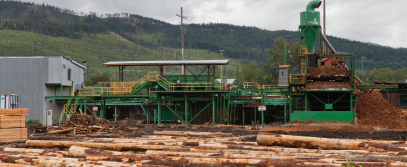Housing Starts and Lumber Pricing Continue Their Decline in Q1 of 2023

On this podcast, we discuss the course of the Forestry Market and explore the impact that factors including the continued low level of new home construction and consumers’ shift away from goods spending are having mills and the pricing of lumber in Q1 2023.
Steve Katz
Hi, everybody, and thanks for taking time out of your busy schedule to listen in on our Hilco global smarter perspective podcasts. Welcome back to our return listeners. And for those joining us for the first time, I’m your host, Steve Katz. Thanks again for tuning in. Today we’re joined by Jesse Marzouk, who’s vice president in Fort St. product specialists to Hilco global for an early q1 update on what’s happening in forestry, with, of course, some emphasis on developments in the Related housing market, which is still under a lot of pressure from continued high interest rates. As we all know, Jesse, thanks for joining us. We talked forestry while back and mid 2022, I believe, as the lumber market was starting to cool and what’s going on? Has that continued and what else are you seeing in the market as we approach the midpoint of q1 this year?
Jesse Marzouk
Thanks for having me on, Steve. Wow, yes, has that continued, we’ve really seen significant month over month declines in lumber pricing ever since the beginning of last year. Composite pricing for framing lumber is down from $1,500 per 1000 board feet in the middle of 2021. And in ended last year at the end of 2022. At about the same level, it was immediately before the pandemic started. Those levels were around $380 per 1000 board feet. So the highs experienced by the market were really an aberration that has subsided. And we’re essentially back to where we would have been had there not been a pandemic at all.
Steve Katz
Yeah, interesting. So, clearly, there have been a lot of other factors of influence as well how, for example, have continued energy prices impacted the mills?
Jesse Marzouk
Good question, Steve. It’s really a two part answer. It’s not only energy, but it’s a story of labor. So obviously saw mills run on energy and moving lumber to and from those mills requires a significant investment in fuel fuel for trucks, fuel for natural gas to run the mills. And with costs running high and demand decreasing. Business still hasn’t really laid off any workers. The reason for that, primarily, I believe, is that there’s still that muscle memory for the times after the pandemic where mill operators had a hard time securing labor. So instead of laying off people, what mills have done is make certain operational adjustments, including taking downtime, because demand has started to weaken. But what’s interesting is that they’re doing it at higher levels in terms of lumber pricing than they’ve done in the past. In the past, mills would have started taking downtime when prices were in the 200 to $250 range. But now we’re seeing Mills take downtime when pricing is much closer to that $400 level. So there’s a cost story for Mills, and it’s one of both energy and labor, with neither of those expected to show significant deterioration in the near future.
Steve Katz
Yeah, that’s understandable. I mean, that muscle memory you talked about. It’s a it’s a painful thing when you let those train workers go and all of a sudden you find you know, you have increased capacity need and you can’t get it back and then you really struggle so very understandable there. And what can you tell us about developments in the housing market since we last spoke, given the strong connection between housing activity and lumber pricing?
Jesse Marzouk
Obviously, there’s that strong connection searchers do. Single Family Housing Starts dropped to their lowest level in five months in December of 2022. With housing less affordable than at any time in recent memory, the sale of existing homes was down 17.8% year over year in 2022 versus 2021. The overall market right now is clearly a refreshed reflection of continued high interest rates, which even though they have softened slightly since we spoke last summer are still for 30 year fixed mortgages slightly above 6%. That’s a big adjustment for folks who are expecting to pay two and a half three or even 4%. Not that long ago when they first committed to homes that they were having built. One report we recently just saw from Yahoo money wise said that 1000s of Americans are backing out of those signed contracts. In fact, about 60,000 individuals are reported to have fallen through and backed out of their contracts in October of last year alone, with demand likely to be tempered by a lack of cheap money for some time to come. There are concerns that the record value run ups in numerous markets can place them at risk. Certain areas in the southeast, particularly in Florida, and in the northwest, including Washington state and Oregon, have been cited as being particularly particularly susceptible. One of the things that I want to reiterate, however, is that with all of this being said with a weakness In the housing market, I want to clearly state that the current environment is nothing like the Great Recession. Leading up to the Great Recession, the housing market overbuilt for four or five years consecutively. If anything leading into the COVID crisis, the housing market had been under Bill. While we are certainly feeling the effects of the massive increase in home prices and interest rates, post COVID. demand for housing is not expected to fall off a cliff like it did back in 2008, and 2009. In 2022, nearly 5 million Americans got married, all of those couples need a place to live, and are expected to put a floor under the housing market in the years to come.
Steve Katz
It’s a tricky balance, right? And you’ve got all these people, like you said, and newly married couples, people looking for homes, and then you’ve got this issue of I put my money down on that house a year ago. And you know, I was gonna pay a mortgage in the $2,000 range. And all of a sudden, it’s $3,500. You know, do I really have a choice in terms of backing out but, but it is quite different, as you’ve clearly pointed out here, and, you know, in terms of where it was going into the Great Recession versus going into this period, so thanks for that observation. And what do you guys you and your team seeing in terms of the paperboard market right now?
Jesse Marzouk
Absolutely. It’s kind of similar to the housing market, you saw a massive increase post COVID Because everyone was staying at home and buying things online, consuming goods instead of services. You know, in certain respects, people are forecasting growth in the corrugated box market of roughly $1.85 billion between 2022 and 2026. growing at a compound annual growth rate of roughly 3.3%. During that four forecast period, as we mentioned, the increase is expected because of the dramatic shift away from goods spending that occurred post COVID. And now we’re seeing that shift from goods to services. And what that’s done is put significant downward pressure on packaging demand. And while this decline was initially stemmed by the fact that many retailers and businesses has businesses have committed to orders and continued building stock, even as consumer demand decreased, the trend became evident. US actual corrugated box shipments in the second half of 2022 declined by 6.4% over 2021 For full year 2022 And two box shipments declined by 3.8% from the prior year, showing that the client accelerated in the second half of 2022 similar lumber mills, box manufacturers and paperboard manufacturers have taken downtime in the third and fourth quarters due to the decline in demand. That still hasn’t stopped prices from declining. And we’re out off about 30 or $40 per ton and paperboard markets from where we were in the middle of 2020. Through.
Steve Katz
And what about the market for printing paper? Obviously, you know, we’re not seeing as many catalogs being printed there. During COVID, there was a lag in terms of some of the pulley manufacturers and others getting inventory. So they didn’t put out catalogs, you’ve got just less printing overall with people not being in the office. What’s what’s happening?
Jesse Marzouk
Absolutely. So amazingly, this has been the weakest market, maybe in the entire economy for the last 20 plus years. It doesn’t seem to seem to be like we’re seeing a lot of excess inventory at the distributor level. Inventory mills are at all time lows right now. Because printers and marketers purchased all the paper they were allocated and 2022 even if they didn’t have to find use or to turn for that stock. Now, some of those are starting to be turned down right now. And this could signal a supply demand balance shift, and either a softening and pricing or determination to slow capacity, which as we referenced earlier, could be the toughest, tough decision, if it means a reduction of skilled labor that might be hard to recoup when needed. But as of now pricing is holding up. And we really haven’t seen that much of a deterioration in the market.
Steve Katz
Interesting. Yeah, I would have thought I would have thought there might be but as you said it might be signaling that direction. Alright, we’re, we’re getting short on time. Any final thoughts that we haven’t touched on relative to the market right now that you still wanted to mention to the listeners?
Jesse Marzouk
Yeah, absolutely. I think I’d really just like to reiterate summarize, by saying that elevated home prices and climbing interest rates have definitely made new home purchases unaffordable for many across the country, housing starts are down and builder confidence is low, and the current pricing trend is likely to continue. As discussed. The impact is further amplified by reduced consumer goods purchase interest in activity. Right now we’re encouraging lenders to engage with their borrowers in the market to ensure a comprehensive understanding of the current business performance, notable challenges and forecasting accuracy. More frequent valuation monitoring may be a worthwhile consideration, given all the fluctuations in pricing, and we welcome the opportunity to discuss and assist in those efforts, as well as the answer any questions lenders and others who are listening may have pertaining to specific exposure within their portfolios.
Steve Katz
And I’m sure some of the listeners will have questions like that. Thanks for joining us, Jesse to give us this earlier update, I really appreciate it. And for those that do have questions, how can they best get in touch with you?
Jesse Marzouk
Thanks to you, the best way to get a hold of me is really via email. It’s J – Marzouk, M A R Z O U K @ Hilcoglobal.com.
Steve Katz
Okay, perfect. Thanks again, Jesse and listeners. As always, we hope that the smarter perspective podcast provided you with at least one key takeaway that you can put to good use in your business or share with a colleague or client to make them that much more successful moving forward. And one more thing, remember that you can check out our other recent podcasts and a full archive of those previously recorded at Hilcoglobal.com Forward slash smarter dash perspectives or on your favorite podcast platform. Lots of good stuff there. All right, well, that wraps it up for today. So until next time for Hilco global I’m Steve Katz.




